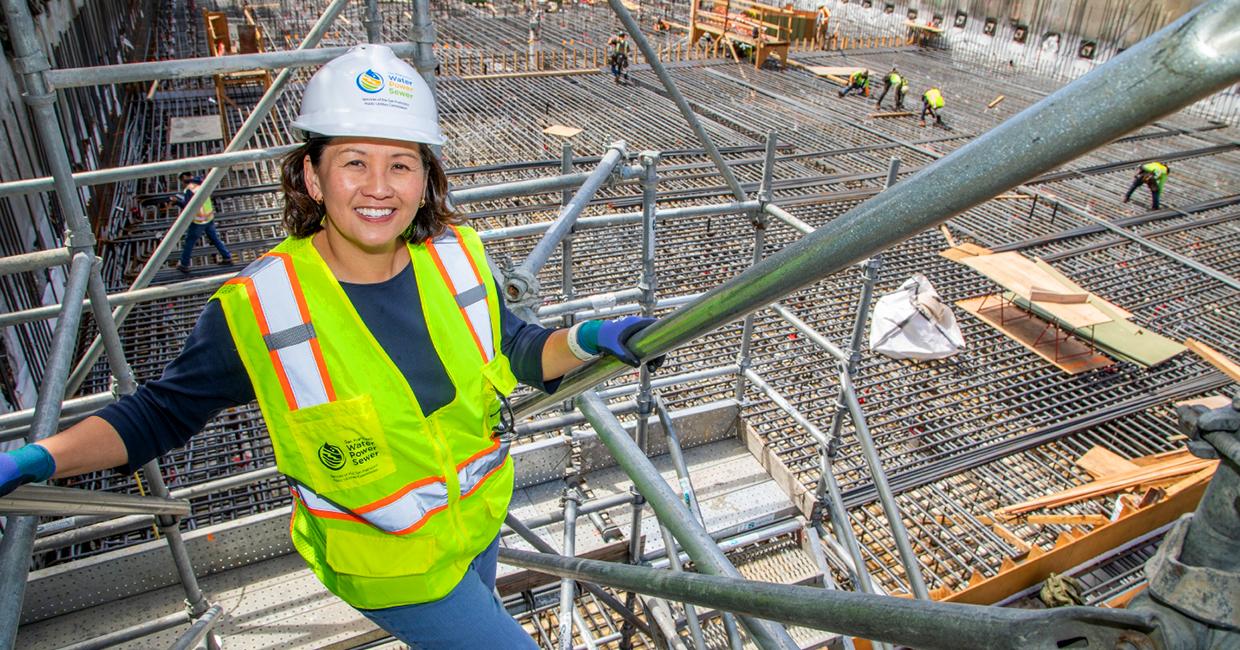
Image Courtesy of the San Francisco Public Utilities Commission Photographer Sabrina K. Wong
In the Bayview this past spring, as huge concrete biosolids digesters began to rise on the Southeast Treatment Plant (SEP) site, Senior Project Manager Carolyn Chiu took a moment to reflect on the progress.
Chiu is the Senior Project Manager on the SFPUC’s Biosolids Digesters Facilities Project (BDFP), the SFPUC’s largest infrastructure project under the Sewer System Improvement Program (SSIP). With Chiu’s leadership, the BDFP began as an idea and is now well underway to replace the aging digester facilities at the SEP with new, expanded, reliable, and modern solids treatment facilities.
“It all started back in the mid-1990s,” said Chiu. “City staff knew that the existing digesters were aging and causing odor complaints in the neighborhood, but rather than continue to do repairs, they decided to build new digesters.” Doing so, she added, would ensure facilities would operate reliably through the foreseeable future and create an opportunity to reduce the facilities’ impact on the community.
After years of public and internal discussion and debate, the BDFP was initiated in 2010 with Chiu on board as Project Manager. What followed was a decade or more of additional public input, neighborhood conversations, budget discussions, robust planning, and design.
“When you’re designing something as important as a new facility that will treat 80% of San Francisco’s storm and wastewater, you have a lot to consider,” said Chiu.
The project would be a generational investment, therefore the pressures internally at the SFPUC were high. “We were starting with a blank page,” said Chiu. “And because of that, we had to make many decisions — from where to put the digesters, to the technology we would use, how we were going to build it, and even the short and long-term operation and ongoing maintenance.”
The project’s challenges were beyond technical. “We are in the Bayview community, where there are historical and ongoing concerns about environmental justice, equity, and jobs.” But the scale of the investments provided a unique opportunity to also support the health and vitality of the surrounding community.
Through the Project Labor Agreement, close coordination with the Office of Economic and Workforce Development, and SFPUC labor outreach efforts in the community, the project provides training and employment opportunities to Bayview-Hunters Point residents and small businesses. In addition, based on public feedback, the project team is making a concerted effort to reduce odors, add public art, and improve the aesthetics and streetscape.
The project team also had to consider what future changes and risks might arise including projecting population growth and analyzing climate and earthquake data.
Because of the SFPUC’s strong commitment to being a good neighbor and building a sustainable future, the project was recently awarded the Envision Platinum Award by the Institute for Sustainable Infrastructure. The award is the new standard for sustainable civil infrastructure similar to LEED rating systems for green building design. Unlike LEED, the Envision certification examines five categories that contribute to the positive social, economic, and environmental impacts on a community.
In the late 1980s, long before she helped to shape the SFPUC’s largest infrastructure project, Chiu landed a job as a summer intern at the Southeast Treatment Plant while earning her degree in Civil Engineering at the University of California, Berkeley.
The experience shaped her career. “I did a lot of grunt work, but I was learning about the wastewater treatment process the whole time,” said Chiu. She recalled several hot summer days working on top of the old digesters grabbing sludge samples.
She ended up staying past the summer, working part-time while still in school. “I like to say that I grew up at this plant,” said Chiu.
The Biosolids Digester Facilities Project (BDFP) is an essential component of a once-in-a-lifetime Southeast Treatment Plant upgrade. The BDFP project is replacing and relocating the entire outdated solids treatment facilities with more reliable, efficient, and modern technologies and facilities. This project will help transform the SEP into a modern resource-recovery facility, allow the SFPUC to meet its levels-of-service goals, and be an attractive place to work and visit.
The new facilities ensure that 100% of biosolids and biogas generated will be beneficially used and provide redundancies for system flexibility. The new design also improves seismic reliability, adapts to anticipated sea-level rise, and limits odors.
When complete, the city’s largest wastewater treatment plant will be transformed into a modern resource recovery center that smells better, looks better and works better.
Read the original article HERE